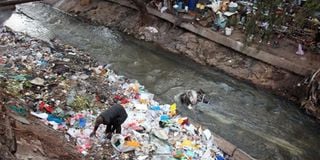Time to restore Nairobi River’s lost glory

Nairobi River is choking on raw human and industrial waste.
What you need to know:
- Reclaiming the reserve will involve relocating the thousands of informal activities to other suitable areas.
Nairobi got its name from a Maasai phrase, “enkare nairobi”, which means cool waters. This was because of the presence of a river which cut through the urban area.
However, with the reckless obsession with industrial, infrastructural and technological advancement, the developer, or rather the modern African, forgot about the river.
The river is now a victim of disastrous pollution resulting from all manner of dumping and discharge. The importance of a river to any community cannot be overemphasised.
Nairobi River is an eyesore. It flows through the very densely populated informal settlements of Nairobi, where sanitation is a luxury and sewerage systems are totally missing.
In the Daily Nation (September 18, 2017), Collins Omullo writes: “Mr James Archer, a Kenyan-borne architect, once observed that he could drink, swim and catch fish in Nairobi River as a mall boy, an experience that is currently, just a distant memory.”
Culture and recreation
Water can be used for culture and recreation. All the damage done to the river can be reversed by following examples of cities that have put their urban rivers to good use.
Many cities in the world have transformed their rivers into great recreational assets. Through the Chicago River Development Plan, Chicago city has developed along the river riparian reserve new trails, parks, boathouses, over-looks, Chicago River walk and a pedestrian promenade.
In Los Angeles, The Los Angeles River Revitalization Master Plan is a project that has seen bike paths, shade devices, pedestrian walkways, landscaped patches and educational signage put along the river riparian reserve.
Other cities with notable urban river developments are Oklahoma, Pittsburgh, Medellin, Columbia, New York and San Antonio.
Nairobi has had its own master plan for rehabilitating Nairobi River but the initiatives have fallen short. There was the Nairobi River Basin Rehabilitation and Restoration Program, Phase I between 2003 and 2006 and Phase II between 2006 and 2009.
The pollution in the river stems from sewers draining into the river and informal activities around the river riparian reserve. The first step should be to clearly demarcate the riparian reserve of the river and declare it a no-go zone for undesignated activities.
The reserve can then be developed into an ecosystem of a varied nature of systems. These can be biking lanes, pedestrian walkways and picnic parks.
Reclaiming the reserve will involve relocating the thousands of informal activities to other suitable areas. This can be combined with slum upgrading relocations.
Sewer drainage and effluent discharge will be addressed through a proper city-wide sewerage system and hefty public fines to anyone linked to discharging and dumping waste into the river.
Mutethia Mutiga, Nairobi




